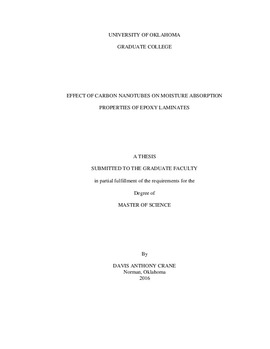| dc.description.abstract | There have been conflicting studies for how multi-walled carbon nanotube reinforcement will affect the moisture absorption properties of an epoxy laminate. The carbon nanotubes were meant to act as a hindrance for the moisture absorption by the epoxy laminate. In this thesis, the effects the multi-walled carbon nanotubes have on the moisture absorption properties of an epoxy laminate were studied. The study was done by fabricating a variety of epoxy laminates with differing planar size, thickness, and nanotube content. Composite samples of three different planar sizes (0.75in x 0.75in, 1.00in x 0.75in, 1.25in x 1.25in), three different thicknesses (1.5mm, 1.7mm, 2.0mm), and seven different nanotube weight percentage levels (0%, 0.25%, 0.5%, 1.0%, 1.5%, 2.0%, and 3.0%) were used to provide a variety of differences in moisture absorption behavior which was used to develop potential trends. Eight samples for each possible combination were made resulting in 504 total samples for gravimetric experiments. The epoxy laminate samples were dried using a vacuum oven, and then placed in a constant-temperature water bath at 25°C where they were weighed periodically. The scanning electron microscope images showed that the nanotube dispersion differs depending on the nanotube content within the sample. The dispersion proved to be homogeneous for the 0.25% and 0.5% nanotube content samples, and somewhat nonhomogeneous for the 1.5% and 3.0% nanotube content samples. The fracture planes on the epoxy samples progressively became smaller as the nanotube content increased, with 1.5% nanotube content samples being an exception.
The addition of nanotubes resulted in an overall increase in the moisture equilibrium of the epoxy laminate samples. The addition of more nanotube content did not show a consistent rise in the moisture equilibrium, but the highest moisture equilibriums were seen for the 2.0% and 3.0% nanotube content samples. The through-the-thickness and planar diffusivities showed opposite trends from each other with the planar diffusivity showing an increase until the 1.0% nanotube content samples followed by a decrease in value, and the through-the-thickness diffusivity showed an initial decrease followed by an increase in value. In general, the change of through-the-thickness diffusivity due to the presence of nanotubes was smaller than the change in the planar diffusivity. Hence, this finding would imply that the addition of nanotubes affects moisture absorption through the composite edges more than the planar surfaces. | en_US |
